|
Did I eat yogurt too much at breakfast?
During waiting for the 8:50 shuttle bus for Nagano Station, I spent time
for a while in a rest room. I did the same thing after arriving at the
station too.
Our couple got on the city bus there at 10:00 and got off at the stop of
Zenkoji Entrance.
We began walking along the temple town to the precincts.
I remembered two things here.
When Mr. K led us 3 AA-Net friends here several years ago, we dropped in
at the famous chili store ("Someday Somewhere Square", October
2009).
6 years ago when our couple came here, we took lunch at the soba-noodle
restaurant just before the precincts (the 43rd story in "Short Story
Square").
There are the stores in memory lined on both sides of the street.
After the temple town, magnificent Nio-mon Gate (Gate of the Two Guardian
Kings) welcomed us.

Nio-mon Gate was originally built in Horeki 2 (1752), was burned down twice
afterward, and the present gate was rebuilt in Taisho 7 (1918).
The upper frame "Jogaku-san" means the mountain name of the temple.
The guardians on both sides were the joint work of Takamura Koun and Yonehara
Unkai. (Until these statues were created, the statues made by the engravers
in the neighboring town Iiyama were set here tentatively, which are now
put in the Nio-mon Gate just in front of Iiyama Temple Town. I hope to
see them tomorrow.)
We stroll along the shopping street on temple grounds.
And here we are in the precincts shown in the following picture map.

Six Jizo and Wet Buddha just on the right.
Now, Sanmon Gate.
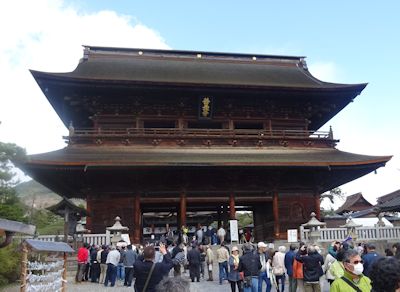
Passing under Sanmon Gate, Main Hall appears right before your eyes.

Zenkoji Main Hall was rebuilt in 1707 in the middle of Edo Period. The
advantage of construction technology that time is said to be reevaluated
now again because the hall was not destroyed by the big earthquake in Koka
4 (1847).
The building is "Wooden Bell Hammer Structure" with roofs covered
with Japanese cypress barks.
"Tohku-tomo Ichido-wa Maire Zenkoji" (Even far away you should
once visit Zenkoji).
I have been here to worship several times, so I am full of grace.
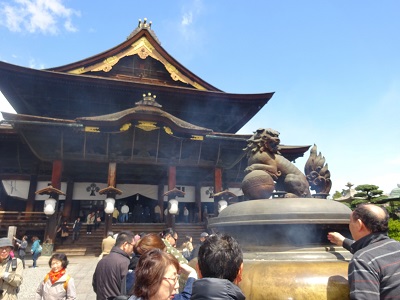
The nade-botoke (Rubbing Priest) "Binzuru Sonja" welcomed us
sitting cross-legged just at the inside of the entrance. Binzuru Sonja
is one of the 16 apprentices of Buddha, and he is said to cure the visiter's
body part by supernatural power if he/she rubs the same part of Binzuru.
I did it for my back-pain part and some other parts in mind, and made sure
of the grace.
Why? I did not take any picture in the Main Hall this time. So, the following
will be some help to me.
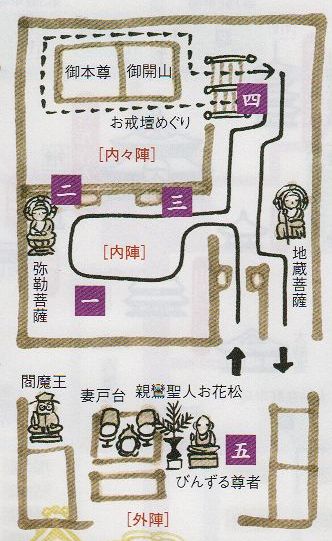 |
|
 |
| (October, 2009) |
We entered Naijin (Inner Prayer Chamber) by the fixed route.
I, myself, had experienced the okaidan-meguri durng the senior 4-member
trip.
It is the walk along a narrow staircase leading down to a completely dark
corridor. In this corridor worshippers try to touch a metal key hanging
on the wall, in order to gain enlightenment. The key represents the pass
to the Western Paradise of the Amida Buddha.
I was happy to accompany Emiko this time.
It is total darkness immediately after getting down the staircase. We only
feel our way in the dark putting the right hand on the wall. Emiko seems
to be fearfully following me.
I finally touched the key to the paradise, so to speak, just under the
main image. Telling it to her, I proceeded a couple of steps and saw the
light.
This experience of both of us made me feel better, while Emiko said, "This
is our second time". In any case a happy ending to us.
I did not know the document museum behind Main Hall though I had ever come
here several times.
Walking to the north-west, we saw a three-story pagoda. It is said to be
"Nippon Churei Den" (Hall for the Loyal People), which enshrines
the spirits of more than 2,400,000 dead soldiers since Boshin War, at the
end of Edo period, until the Pacific War, in Showa period.

Zenkoji Historical Document Museum was next to the pagoda. We entered it
and looked around a lot of Buddhist statues and documents.
We got back to Main Hall again.
I noticed the bell tower on the side.
It is on the stone wall. It was rebuilt in Kaei 6 (1853). The pillars are
6 pieces, related to the 6 myogo (6 prayer kanji letters) "南無阿弥陀仏"
(na-mu-a-mi-da-butsu), and the roof is hiwada-buki style. The bell was
cast in Kanbun 7 (1667), 1.8m high and 1.16m in caliber.
In Nagano Olympic (1998), it rang loudly as the sound of the opening celebration.
We entered Sanmon Gate lastly.
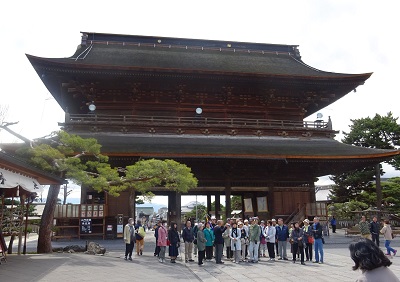
| This gate was built in Kanen 3 (1750) in the middle of Edo Period, 20m
wide, 8m deep and 20m high. The roof has about 180 thousand pieces of sawara
plates, which is now the largest tochi-buki building.
Emiko asked me whether I know 5 doves are hidden in those 3 kanji letters
or not.
(It is called the Frame of Dove Letters.)
|
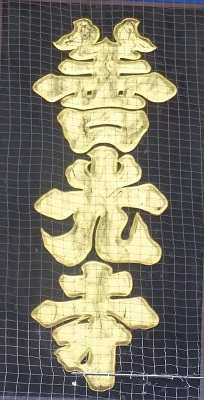 |
We went up the steep stairs, worshipped the statue "Monju-bosatu-kishi" guarded by the four deities, and looked down at the land.

On the land below is joyful like this.
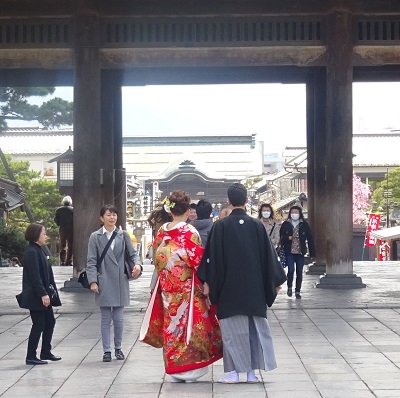
Zenkoji Temple is near the hometown "Kashiwa-bara" of Kobayashi
Issa, a famous haiku poet in Edo Period.
The following haikus are some of Issa's.
| 初雪や雪駄ならして善光寺 |
| hatsuyuki ya setta narashite Zenkoji |
| 善光寺やかけ念仏で明けの春 |
| Zenkoji ya kakenenbutsu de ake no haru |
| そば時や月のしなのゝ善光寺 |
| sobadoki ya tsuki no Shinano no Zenkoji |
| 春風や牛に引かれて善光寺 |
| harukaze ya ushi ni hikarete Zenkoji |
| 雀らもおや子連れなり善光寺 |
| suzumera mo oyako zurenari Zenkoji |
|
-----
The soba-noodle restaurant "Daimaru" is open across the intersection
from Nio-mon Gate. In autumn 6 years ago, we entered it before visiting
Zenkoji and tasted the newly handmade soba.
We had planned to do so this time too, and entered Daimaru after noon.
Emiko ordered vegetable warm soba and I ordered zaru soba.
Both of us were satisfied with the soba noodle of Togakushi brand. While
we were chatting with a lady staff, 4 foreign-looking people came in and
sat on the tatami mat.
I make a sidelong glance to find they are talking in English and are taking
time to choose their dishes on the English menu. The staff treating them
seems not fluent in English but skillful. After a while their dishes are
carried on their table.
I talked to them just as I was leaving. They are from Sydney, Australia,
and the first time to visit Japan.
They seemed to be glad surprisingly of my sudden talk in English.
They are going to visit Zenkoji from now.
I said "Enjoy the wonderful temple". Then they said "Sure
we will".
They accepted my taking their photo.
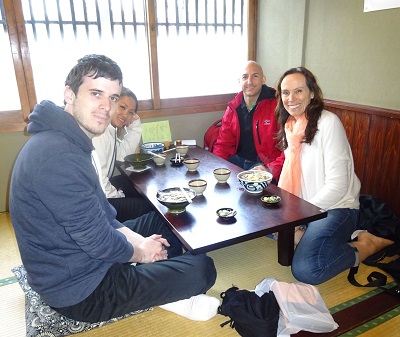
At any rate, it is so cold. It seems less than 10 degrees centigrade, but the wind surely makes it feel much colder.
Though reluctant in mind, I followed Emiko's idea to walk to the station.
On the way, we had a break at a certain department store and at last got
to the station.
We had reserved the last shuttle bus of 4:00 p.m., but the change to the
previous 3:00 bus was accepted.
As soon as we arrived at the hotel, I headed to the large bath. The temple
tour in Matsushiro never occurred to my mind.
Zenkoji, Other Pictures
|